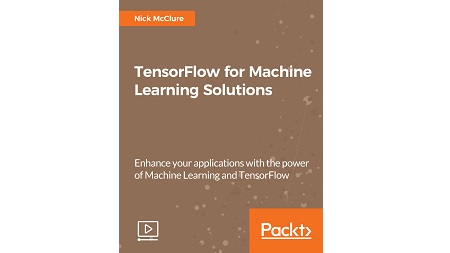
English | MP4 | AVC 1920×1080 | AAC 44KHz 2ch | 1h 37m | 453 MB
Explore machine learning concepts using the latest numerical computing library – TensorFlow
TensorFlow is an open source software library for Machine Intelligence. The independent solutions in this video course will teach you how to use TensorFlow for complex data computations and will let you dig deeper and gain more insights into your data than ever before. You’ll work through solutions on training models, model evaluation and sentiment analysis – each using Google’s machine learning library TensorFlow.This guide starts with the fundamentals of the TensorFlow library which includes variables, matrices, and various data sources. Moving ahead, you will get hands-on experience with Linear Regression techniques with TensorFlow
This video course takes a solution-based approach where every topic is explicated with the help of a real-world example.
What You Will Learn
- Become familiar with the basics of the TensorFlow machine learning library
- Get to know Linear Regression techniques with TensorFlow
- Learn SVMs with hands-on solutions
- Implementing Nearest Neighbor Methods
Table of Contents
01 The Course Overview
02 How TensorFlow Works
03 Declaring Tensors
04 Using Placeholders
05 Working with Matrices
06 Declaring Operations
07 Implementing Activation Functions
08 Working with Data Sources
09 Operations in a Computational Graph
10 Layering Nested Operations
11 Working with Multiple Layers
12 Implementing Loss Functions
13 Implementing Back Propagation
14 Working with Batch and Stochastic Training
15 Combining Everything Together
16 Evaluating Models
17 Using the Matrix Inverse Method
18 Implementing a Decomposition Method
19 Learning the TensorFlow Way of Linear Regression
20 Understanding Loss Functions in Linear Regression
21 Implementing Deming regression
22 Implementing Lasso and Ridge Regression
23 Implementing Elastic Net Regression
24 Working with a Linear SVM
25 Reduction to Linear Regression
26 Working with Kernels in TensorFlow
27 Implementing a Non-Linear SVM
28 Implementing a Multi-Class SVM
29 Working with Nearest Neighbors
30 Working with Text-Based Distances
31 Computing with Mixed Distance Functions
32 Using an Address Matching Example
33 Using Nearest Neighbors for Image Recognition
Resolve the captcha to access the links!